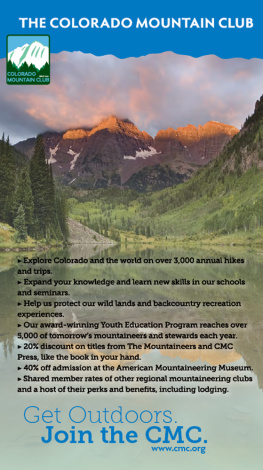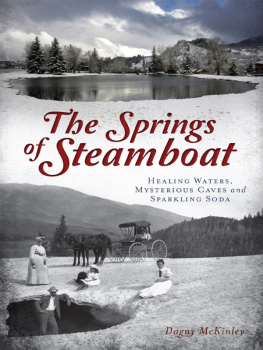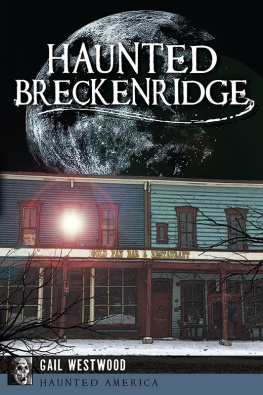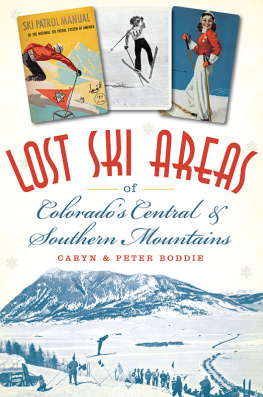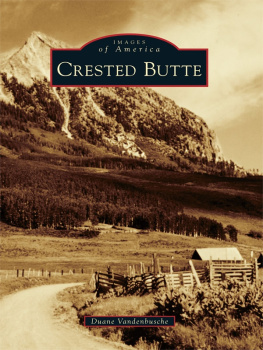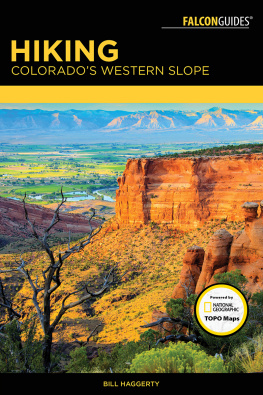Evelyn Spence - Explorers Guide Colorados Classic Mountain Towns
Here you can read online Evelyn Spence - Explorers Guide Colorados Classic Mountain Towns full text of the book (entire story) in english for free. Download pdf and epub, get meaning, cover and reviews about this ebook. publisher: Countryman Press, genre: Home and family. Description of the work, (preface) as well as reviews are available. Best literature library LitArk.com created for fans of good reading and offers a wide selection of genres:
Romance novel
Science fiction
Adventure
Detective
Science
History
Home and family
Prose
Art
Politics
Computer
Non-fiction
Religion
Business
Children
Humor
Choose a favorite category and find really read worthwhile books. Enjoy immersion in the world of imagination, feel the emotions of the characters or learn something new for yourself, make an fascinating discovery.

- Book:Explorers Guide Colorados Classic Mountain Towns
- Author:
- Publisher:Countryman Press
- Genre:
- Rating:3 / 5
- Favourites:Add to favourites
- Your mark:
- 60
- 1
- 2
- 3
- 4
- 5
Explorers Guide Colorados Classic Mountain Towns: summary, description and annotation
We offer to read an annotation, description, summary or preface (depends on what the author of the book "Explorers Guide Colorados Classic Mountain Towns" wrote himself). If you haven't found the necessary information about the book — write in the comments, we will try to find it.
Explorers Guide Colorados Classic Mountain Towns — read online for free the complete book (whole text) full work
Below is the text of the book, divided by pages. System saving the place of the last page read, allows you to conveniently read the book "Explorers Guide Colorados Classic Mountain Towns" online for free, without having to search again every time where you left off. Put a bookmark, and you can go to the page where you finished reading at any time.
Font size:
Interval:
Bookmark:
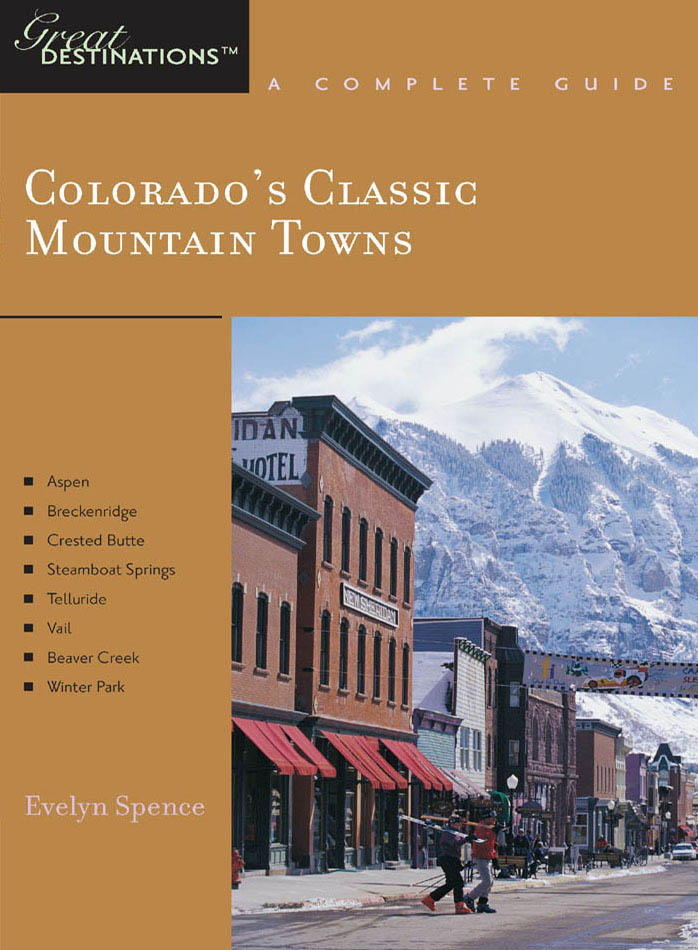
Putting together a guidebook is a daunting proposition, and I couldnt have done it without the generous help of many people. First thanks go to my colleagues at Countryman Press: Kermit Hummel, for approaching me with this idea; Jennifer Thompson, for her steady organization; and Philip Rich, for spit-shining my words. Im especially grateful to my contacts at the Colorado ski resorts I was lucky enough to visit: Kristin Rust, Nicky DeFord, Katie Coakley, Erin Lentz, Christina Schleicher, Jen Brown, Maryhelyn Kirwan, April Prout, Jennifer deBerge, Mike Lane, and Riley Polumbus. And, lastly, to a whole list of friends and family: There are too many of you to count, but your words of encouragement, open ears, and flattery kept my head above water.
Dont let stories about Jack Nicholson, Goldie Hawn, Cher, Kevin Costner, Ringo Starr, Arab princes, billionaires, heiresses, ocelet coats, Fendi bags, Town & Country, or Manolos keep you away from Aspen. Yes, home prices average close to $4 million (and recently one hit the market for over $120 million), and the boutiques, galleries, restaurants, bars, and hotels are world class (often with tabs to match). But none of this can change a few simple facts: The four ski hills hereAspen Mountain, Snowmass, Aspen Highlands, and Buttermilkhave some of the best and most varied terrain in the state, if not the country; despite its snooty CV, the town is actually very open-minded and inclusive, with competitions like the Winter X Games (teenage ski punks), events like Gay Ski Week (needs no explanation), and landmarks like the Woody Creek Tavern (made famous by beloved local gonzo Hunter S. Thompson); and with all that money, worldliness, and intellectual curiosity, the local art, culture, and music scene matches that of some international cities.
The Utes first inhabited the Aspen area, calling it Shining Mountainbut it really exploded when silver miners arrived during the 1870s. Thanks to the passage of the Sherman Silver Purchase Act in 1878, Colorados mining boom kicked off in a big way: The legislation required that the Fed buy silver every month and have it coined into silver dollars. Prospectors branched out from Leadville (a nearby high-mountain town where silver was discovered in 1878) in all directions: William Hopkins and company to the Roaring Fork Valley, between Glenwood Springs and Aspen; Charles E. Bennett to what is now Independence Pass; and Henry Staats to Hunter Creek. Those first winters brought heavy snowfalland early settlers learned quickly from a few natives of Sweden in camp to use the Norwegian snowshoe, or ski. Aspens fate, perhaps, was already sealed.
In 1880, B. Clark Wheeler arrived from Leadville (then a 17-day journey on those Norwegian snowshoes), surveyed the area, and changed the name from Ute City to Aspen, after the telltale white-barked tree. By 1882, mines around town had produced $44 million in silver and lead ores, and by 1890, the population had rocketed to 10,000. At one point, Aspen was the third-largest city in the entire state behind Denver and Leadville. Jerome B. Wheeler (no relation to B. Clark), a president of Macys who moved to Colorado in 1882 for his wifes health, took full advantage of the boom and established himself as the father of Aspen: On top of being a rancher, he built the areas first smelter, founded a bank, and built an opera house and a hotelboth of which still stand. After the Denver & Rio Grande and Colorado Midland railroads arrived in 1887 and 1888, no fewer than 14 trains rolled in a day.

But even back then, Aspen was different from the typical bawdy mining camp: There were four daily newspapers. A race track. Polo grounds. Literary meetings. Wives of mine bosses shopped in Paris and New York, bringing high fashion into the high mountains. As is true today, all the cash led to an unusual sophistication and intellectual diversity.

Tree blossoms frame the historic Wheeler Opera House. Burnham W. Arndt
Everything came crashing down with the repeal of the Sherman Silver Purchase Act in 1893: Men like Jerome Wheeler lost their fortunes literally overnight, mines closed, buildings started sagging, and population stats dropped from 12,000 at Aspens peak to 700 by World War II. A few hardscrabble ranchers stuck it out, herding sheep and cattle, growing potatoes, and watching the natural beauty return to the hills. City lots were available for $5 in the 1930s. These days, locals look back and call it The Quiet Years.
Despite the somewhat depressing conditions, locals still managed to come up with the idea to start a ski area, though: Highlands Bavarianthe first ski area in Coloradoopened in 1936 near the now-abandoned town-site of Ashcroft, and Swiss skier Andr Roch put up a boat tow (two mine hoists, a Ford Motel T motor, and a pair of sleds that each fit eight people) on Ajax Mountain in 1937. His Roch Run hosted National Alpine championship races in 1941, putting the nascent ski resort on the winter recreational map. Austrian-born ski instructor Friedl Pfeifer moved to town after the war, and soon persuaded Chicago cardboard-box tycoon Walter Paepcke to develop a world-famous, European-style resort. And Paepcke went at it with a vengeance: He organized an international Goethe Bicentennial in 1949, with a tent designed by Eero Saarinen and performances by the Minneapolis Symphony Orchestra, establishing Aspens cultural legacy (and the ever-widening idea of the mountain summer festival). He brought in the World Alpine Ski Championships in 1950. He gave people paint to spruce up their houses. He renovated the Hotel Jerome and the Wheeler Opera House.
And his vision paid off. The Kennedy family came. John Denver came. Hunter S. Thompson came. Chevy Chase. Private jets lined up at the airport. Despite the big names, it wasand still isan extremely liberal place: As one writer said, Aspen was a strange mix of hedonism, industry, liberality, athleticism, and unpretentiousness. People smoked pot on the street. The police had long hair. Skiers soon had three more mountains to choose fromButtermilk, Aspen Highlands, and Snowmass. Legendary racers like Billy Kidd and Ingemar Stenmark made appearances in alpine races. In cultural, pop-cultural, and athletic senses, with its radical-chic sensibility, Aspen captured the nations imaginationand continues to hold its fascination. All sappiness aside, its a must-stop. Save up and splurge. Dirtbag it, or just drive through. Its well worth it.
A SPEN
 Annabelle Inn
Annabelle Inn
Innkeeper: Charley Case
877-266-2466, 970-925-3822
annabelleinn.com
info@annabelleinn.com
232 W. Main St., Aspen
Price Range: $100$399, including breakfast
Credit Cards: AE, D, MC, V
Children: Y
Pets: N
Handicap Accessible: Y
The new Annabelle (which used to be the Christmas Inn, founded in 1948) has the mining shackchic feeling that pervades many new homes in Crested Butte and greater Aspen and has now been brought to Main Street: Its a blend of rough-hewn salvaged timber, rusty corrugated metal, railroad tielike beams, and old skis from different eras (theres an ancient pair of Olins next to the inns clock tower). The 35 roomseither standard, deluxe, or premium (on the third floor, away from the road noise and overlooking the beautiful garden of a local)are all decorated and named differently: The Spruce has a whimsical, curly-cued wrought-iron bed and handmade quilt; Karens has a bent birch-wood four-poster canopy; Norway has a white peeled-paint queen and a Tiffany lamp; and Cloud Nine has one wall with logs and chinking. The courtyard in the middle of the inn has a Japanese-style waterfall, a stream garden, and a fire pit; there are also two hot tubs (and they screen ski movies alongside one of them every evening). Dont want to watch another Warren Miller flick? Nosh on complimentary cookies and cocoa in the lounge.
Font size:
Interval:
Bookmark:
Similar books «Explorers Guide Colorados Classic Mountain Towns»
Look at similar books to Explorers Guide Colorados Classic Mountain Towns. We have selected literature similar in name and meaning in the hope of providing readers with more options to find new, interesting, not yet read works.
Discussion, reviews of the book Explorers Guide Colorados Classic Mountain Towns and just readers' own opinions. Leave your comments, write what you think about the work, its meaning or the main characters. Specify what exactly you liked and what you didn't like, and why you think so.

